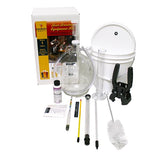Kegging
Kegging will change your life in so many fantastic ways- specifically, no more time wasted scrubbing labels or bottles, no more time wasted cleaning, sanitizing, and filling so many little bottles, and (your significant other will appreciate this) that ever-expanding bottle collection that's been growing like The Blob and is now creeping out of the closet and basement will miraculously go away!
So... How does one do it? First of all, we periodically offer free kegging workshops, so feel free to call or check our event calendar to find out more about those.
Equipment- We do sell complete kits, but you can also piece together your own if you find a deal
CO2 tank
Regulator
Hoses/Fittings/Disconnects
Corny keg (used, old soda kegs; there are also new ones being produced, but the price is much higher)
Fridge to store your keg- old fridge, a kegerator, or a chest freezer with a temp controller on it works fine.
Theory-
A basic understanding of gas laws will help you immensely and make kegging a breeze. First, check out a carbonation chart, second, always bear in mind the concept of equilibrium. Gas will seek balance. More on that in the Process section....
First of all, your beer will need to be cold before it will absorb CO2. How cold? Check the chart. With your beer in a keg, check the temperature of your fridge and then determine how carbonated you want the beer to be; this is where you refer to the carb chart. For example, most American IPAs are carbed to around 2.5 volumes CO2. If your fridge is set to 38F, then you'd set your regulator at 11psi. After about 8 or 9 days at 38F under 11psi, your beer will be perfectly carbed to 2.48 volumes.
Process-
This is where it all comes together and makes more sense. We can really lay down the theory in practical terms now. Here we'll drop some awesome tips and tricks to help you get the most out of kegging.
So your beer is done fermenting. Hooray! Prepare it for siphoning and clean/sanitize your keg. Remember, never use bleach or Hydrogen Peroxide (that means you, OneStep!) on stainless steel as this will cause it to pit and lose its passive layer. Safe cleaners include Oxygen Brewery Wash and PBW. Sanitizers we carry include Io-Star and StarSan.
After you keg and siphoning equipment is sanitized, prepare to rack as usual, with your fermenter elevated above the keg. With the keg lid off, hook up your gas in and purge your keg with CO2; it helps to hold your hand over the keg opening to create some pressure in the keg and help force out the oxygen (remember, CO2 is denser than air and will settle out below it). Once purged, just siphon your product into the keg, minimizing splashing as always.
Once filled, replace the lid on the keg, making sure it's fitting the proper direction; usually the lids seal facing one direction, but not the other. It helps to mark a line from the keg to the lid with a Sharpie marker once you determine the proper fit; that will save you time and gas. Purge out any remaining oxygen by pulling several times on the pressure relief valve in the lid. If you're using pinlock kegs, your lid probably lacks the prv, in which case you'll have to remove the gas disconnect and press down the poppet in order to purge.
Now your keg is full! Get it into your refrigerator and hooked up to your gas. To determine the proper setting on the regulator, refer to a carbonation chart, like this one! Liquids are more apt to absorb CO2 when cold, so colder temps require less pressure. So.... carb times. Heeeeeeere we go-
Carbing-
It is possible to naturally carbonate in a keg (using priming sugar, DME, etc.), however, most people do not, choosing instead to force carb. If you do want to naturally carbonate your beer, make sure you pressurize your keg with around 5-10 psi to seal the lid, otherwise your CO2 will bleed out and you'll have flat beer.
As for force carbing. Again, refer to the carb chart. There are multiple ways to force carb, but most of the websites and forums you come across address two ways, dubbed "Set it and Forget it" or "Shake it." The first one is a simple matter of checking your carb chart and the temperature of your fridge. Set the regulator to the corresponding PSI (i.e. if you want 2.5 volumes of CO2 in your beer, and your fridge is 38F, set the regulator to 11PSI) and after about 8 or 9 days, the gas will be fully infused into the beer. It will be at equilibrium, with equal pressure within the beer and in the headspace. That's set and forget.
Shake it, or as I like to refer to it, "shake the crap out of it so it's good and overcarbed and then you have to let it warm up to off gas" method. This method involves getting your beer cold (it takes roughly 24 hours for the full volume of liquid to wholly chill to your fridge temp), setting the regulator to about 30 psi, and shaking the crap out of it, or rolling it, for about 5 minutes. Turn the regulator down to normal pressure (i.e. 11psi) and bleed the excess pressure using the prv. Then, you have to let it settle for awhile.
Another method, kind of a hybrid of these two, is to get your keg cold and turn up the regulator to about 30 psi for roughly 24 hours. These last two methods get your beer carbed, but it's very imprecise.
If, for some reason, you need it done quickly and must shake it, there's a better way! Get the keg cold, set to the desired PSI on your regulator as if you were doing "set and forget." Shake the keg with the gas hooked up. You'll hear the regulator hissing as it feeds gas to the keg. After about 10-15 minutes of shaking (depending on how vigorous you are), the regulator will stop making noise. At this point, everything is at equilibrium. You'll still need to let the beer settle for a bit, but you'll have perfectly carbed beer just in time for the party!
It's Carbed, Now What?
Refer to the carb chart, and keep the PSI set wherever it needs to be for your desired PSI (i.e. 11PSI as per earlier example). If you drop the serving pressure, for example from 11PSI to 6PSI, it creates a vacuum in the headspace of the keg. The gas will move to equilibrium. This means that if the pressure in the beer (11PSI) exceeds that in the headspace (6PSI), the gas will move out of the beer and into the headspace until it reaches equilibrium. This results in a beer with less carbonation, and you'll be wondering why it is still pouring at a seemingly higher pressure. Now, if you're just drinking the beer at a party or something, then there won't really be enough time for any of this to matter. Under ordinary conditions, though, you'll definitely want to keep this in mind.
If you're doing something that's highly carbonated and therefore you need to set your regulator to something crazy, like 14PSI, you WILL have foaming problems because the beer will come blasting out. The solution is not to turn down your regulator, but rather to use a longer length of tubing to create more resistance. Read this to figure out whatcha need!


